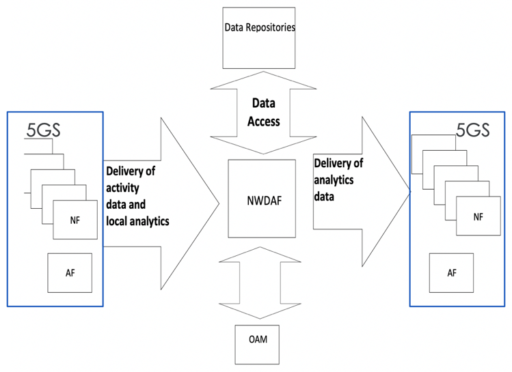Introduction
5G networks promise to be faster than 4G, more reliable, massively scalable, and will enable mobile network operators (MNOs) to develop a broad range of new applications and services for consumers and businesses.
Everything will increase in number: connected devices, 5G cell sites, radio elements and antennae, bandwidth, cloud-native infrastructure, and more. To meet this demand, machine intelligence must foster self-monitoring, self-diagnosing, and self-driving infrastructures.
5G Network Data Analytics Function (NWDAF) is designed to streamline the way core network data is produced and consumed, as well as to generate insights and take actions to enhance the end-user experience.
What is NWDAF?
NWDAF defined in 3GPP TS 29.520 incorporates standard interfaces from the service-based architecture to collect data by subscription or request model from other network functions and similar procedures. This is to deliver analytics functions in the network for automation or reporting, solving major custom interface or format challenges.
It’s a 3GPP standard method used to collect data from user equipment, network functions, and operations, administration, and maintenance (OAM) systems, etc. from the 5G Core, Cloud, and Edge networks that can be used for analytics.

NWDAF Model
NWDAF provides machine intelligence in the 5G Core and provides a centralized, predictive analytics platform for 5G core networks. Without this critical function, the network would struggle to deliver the performance required for more complex 5G network slices.
NWDAF Functions in 5G Network
With the NWDAF solution, MNOs will be able to evolve to the standard smoothly, benefit from decreased TCO while using the standard, and use analytics models on top of the standard as NWDAF can:
- Consumes statistics, metrics, and events from 5G network functions.
- Retrieves management statistics from OAM.
- Network Function (NF) discovery and identification.
- Performs ML modeling on refined streamed data and ML model developed based on ingested statistics.
- 5G network optimization, cost efficiency, and resource management.
- 5G monetization and ROI with guaranteed Quality of Experience and Quality of Service for customers.
Benefits with 5G NWDAF
NWDAF is designed to overcome market fragmentation and proprietary solutions in the area of network analytics, streamlining the way core network data is produced and consumed, as well as generating insights and taking actions based on these insights.
NWDAF addresses three primary standardization points:
- Data collection interface from network nodes.
- Predefined analytics insights.
- Data exposure interface for consumers.
So with NWDAF, MNOs can:
- Introduce a set of net new 5G-based services.
- Generate the machine intelligence critical for service orchestration and network automation.
- Assure QoE and SLAs for 5G services by proactively adapting to network conditions.
- Prevents performance issues by predicting network deterioration before it happens and taking corrective action.
- Maximizes return on network capacity investments.
- Prevents over-engineering by continuously tuning the network and balancing network loads.
- Deploy multi-vendor networks with confidence, leveraging the unique capabilities of best-of-breed products.
- Augment the ability of their operations staff to serve as planners rather than front-line workers.
MNOs do not need to integrate and manage NWDAF products from multiple suppliers, resulting in greater complexity, higher cost, and possibly supplier-specific solutions that lead to vendor lock-in and siloed operations.
5G NWDAF Use Cases
3GPP TR 23.791 listed the following formula-based/AI-ML analytics use cases for 5G using NWDAF:
- Load-level computation and prediction for a network slice instance.
- Service experience computation and prediction for an application/UE group.
- Load analytics information and prediction for a specific NF.
- Network load performance computation and future load prediction.
- UE Expected behavior prediction.
- UE Abnormal behavior/anomaly detection.
- UE Mobility-related information and prediction.
- UE Communication pattern prediction.
- Congestion information – current and predicted for a specific location.
- Quality of service (QoS) sustainability involves reporting and predicting QoS change.
An Example Use Case of NWDAF
An example use case of one of the NWDAF would be to send KPIs to a policy control function to decide about security on a noisy node or determine if QoS is unequal across subscribers in a cell. Each logical data analytics module is implemented as multiple instances for different use cases and purposes.
For instance, the Big Data module in the management and orchestration layer could be implemented as multiple instances per domain (e.g., RAN data analytics, VNF data analytics, etc.) at different levels (e.g., cross/intradomain). This framework allows for a dedicated data analytic module design at different layers, also enabling cross-layer optimization.
Conclusion
MNOs are familiar with the benefits of using analytics in telco networks, which include reducing operations and capital costs and generating new revenue. As they move to 5G, analytics play an even bigger role beyond the traditional boundaries of telco networks including RAN, and core operations/business support systems (OSS/BSS).
Hence, having a standards-defined 3GPP NWDAF for the analytics needs of 5G, deployed with the right scalable, optimized, and distributed architecture, will simplify 5G/hybrid network deployment and management and is critical to ensuring the very best customer experience. It is network-aware and can interface with various control and data plane network functions to collect events that are of interest for analysis.
References
- Ericsson,5G network data analytics function (NWDAF).
- 3GPP, Network Data Analytics Services.
- Inform, Automate the 5G network with machine learning and data analytics.
- Netscout, 5G Network Core Data Analytics Framework.













